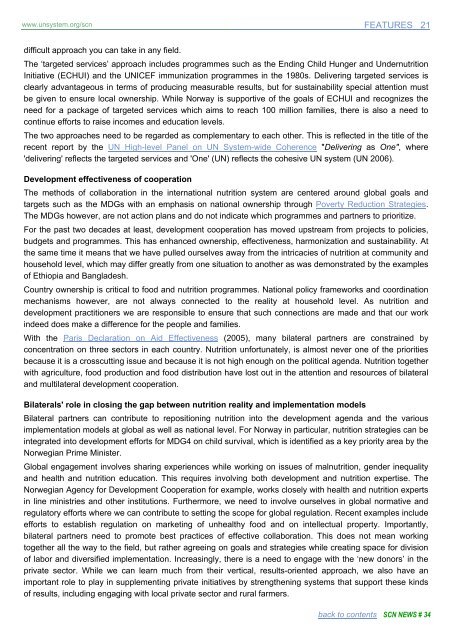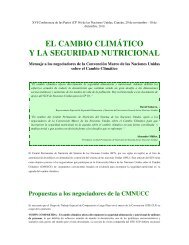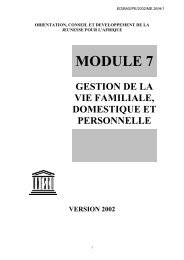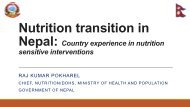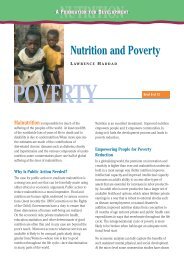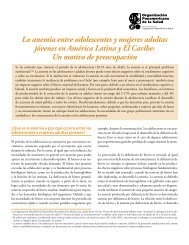SCN News No 34 - UNSCN
SCN News No 34 - UNSCN
SCN News No 34 - UNSCN
Create successful ePaper yourself
Turn your PDF publications into a flip-book with our unique Google optimized e-Paper software.
www.unsystem.org/scn FEATURES 21<br />
difficult approach you can take in any field.<br />
The ‘targeted services’ approach includes programmes such as the Ending Child Hunger and Undernutrition<br />
Initiative (ECHUI) and the UNICEF immunization programmes in the 1980s. Delivering targeted services is<br />
clearly advantageous in terms of producing measurable results, but for sustainability special attention must<br />
be given to ensure local ownership. While <strong>No</strong>rway is supportive of the goals of ECHUI and recognizes the<br />
need for a package of targeted services which aims to reach 100 million families, there is also a need to<br />
continue efforts to raise incomes and education levels.<br />
The two approaches need to be regarded as complementary to each other. This is reflected in the title of the<br />
recent report by the UN High-level Panel on UN System-wide Coherence "Delivering as One", where<br />
'delivering' reflects the targeted services and 'One' (UN) reflects the cohesive UN system (UN 2006).<br />
Development effectiveness of cooperation<br />
The methods of collaboration in the international nutrition system are centered around global goals and<br />
targets such as the MDGs with an emphasis on national ownership through Poverty Reduction Strategies.<br />
The MDGs however, are not action plans and do not indicate which programmes and partners to prioritize.<br />
For the past two decades at least, development cooperation has moved upstream from projects to policies,<br />
budgets and programmes. This has enhanced ownership, effectiveness, harmonization and sustainability. At<br />
the same time it means that we have pulled ourselves away from the intricacies of nutrition at community and<br />
household level, which may differ greatly from one situation to another as was demonstrated by the examples<br />
of Ethiopia and Bangladesh.<br />
Country ownership is critical to food and nutrition programmes. National policy frameworks and coordination<br />
mechanisms however, are not always connected to the reality at household level. As nutrition and<br />
development practitioners we are responsible to ensure that such connections are made and that our work<br />
indeed does make a difference for the people and families.<br />
With the Paris Declaration on Aid Effectiveness (2005), many bilateral partners are constrained by<br />
concentration on three sectors in each country. Nutrition unfortunately, is almost never one of the priorities<br />
because it is a crosscutting issue and because it is not high enough on the political agenda. Nutrition together<br />
with agriculture, food production and food distribution have lost out in the attention and resources of bilateral<br />
and multilateral development cooperation.<br />
Bilaterals' role in closing the gap between nutrition reality and implementation models<br />
Bilateral partners can contribute to repositioning nutrition into the development agenda and the various<br />
implementation models at global as well as national level. For <strong>No</strong>rway in particular, nutrition strategies can be<br />
integrated into development efforts for MDG4 on child survival, which is identified as a key priority area by the<br />
<strong>No</strong>rwegian Prime Minister.<br />
Global engagement involves sharing experiences while working on issues of malnutrition, gender inequality<br />
and health and nutrition education. This requires involving both development and nutrition expertise. The<br />
<strong>No</strong>rwegian Agency for Development Cooperation for example, works closely with health and nutrition experts<br />
in line ministries and other institutions. Furthermore, we need to involve ourselves in global normative and<br />
regulatory efforts where we can contribute to setting the scope for global regulation. Recent examples include<br />
efforts to establish regulation on marketing of unhealthy food and on intellectual property. Importantly,<br />
bilateral partners need to promote best practices of effective collaboration. This does not mean working<br />
together all the way to the field, but rather agreeing on goals and strategies while creating space for division<br />
of labor and diversified implementation. Increasingly, there is a need to engage with the ‘new donors’ in the<br />
private sector. While we can learn much from their vertical, results-oriented approach, we also have an<br />
important role to play in supplementing private initiatives by strengthening systems that support these kinds<br />
of results, including engaging with local private sector and rural farmers.<br />
back to contents <strong>SCN</strong> NEWS # <strong>34</strong>


